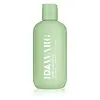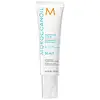What's inside
What's inside
 Key Ingredients
Key Ingredients

 Benefits
Benefits

 Concerns
Concerns

 Ingredients Side-by-side
Ingredients Side-by-side

Water
Skin ConditioningSodium Lauroyl Methyl Isethionate
CleansingCocamidopropyl Betaine
CleansingDisodium Laureth Sulfosuccinate
CleansingSodium Lauryl Sulfoacetate
CleansingGlycol Distearate
EmollientGlycerin
HumectantPiroctone Olamine
PreservativeAloe Barbadensis Leaf Extract
EmollientButylene Glycol
HumectantDextran
Trifolium Pratense Flower Extract
AstringentGuar Hydroxypropyltrimonium Chloride
Skin ConditioningPEG-150 Pentaerythrityl Tetrastearate
EmulsifyingPPG-2 Hydroxyethyl Cocamide
EmulsifyingDehydroacetic Acid
PreservativeBenzoic Acid
MaskingSodium PCA
HumectantLactic Acid
BufferingCitric Acid
BufferingSodium Benzoate
MaskingPotassium Sorbate
PreservativeAcetyl Tetrapeptide-3
Skin ProtectingPhenoxyethanol
PreservativeParfum
MaskingWater, Sodium Lauroyl Methyl Isethionate, Cocamidopropyl Betaine, Disodium Laureth Sulfosuccinate, Sodium Lauryl Sulfoacetate, Glycol Distearate, Glycerin, Piroctone Olamine, Aloe Barbadensis Leaf Extract, Butylene Glycol, Dextran, Trifolium Pratense Flower Extract, Guar Hydroxypropyltrimonium Chloride, PEG-150 Pentaerythrityl Tetrastearate, PPG-2 Hydroxyethyl Cocamide, Dehydroacetic Acid, Benzoic Acid, Sodium PCA, Lactic Acid, Citric Acid, Sodium Benzoate, Potassium Sorbate, Acetyl Tetrapeptide-3, Phenoxyethanol, Parfum
Water
Skin ConditioningCocamidopropyl Betaine
CleansingStearyl Stearate
EmollientArgania Spinosa Shell Powder
AbrasiveGlycerin
HumectantPolysorbate 20
EmulsifyingArgania Spinosa Kernel Oil
EmollientHippophae Rhamnoides Fruit Oil
Skin ProtectingVaccinium Myrtillus Fruit Extract
Skin ConditioningSwertia Japonica Extract
Skin ConditioningRosa Canina Fruit Oil
EmollientAdansonia Digitata Seed Oil
EmollientFumaria Officinalis Extract
Skin ConditioningMelissa Officinalis Leaf Extract
Skin ConditioningSaccharum Officinarum Extract
MoisturisingAcer Saccharum Extract
Skin ConditioningEuphorbia Cerifera Wax
Citrus Limon Fruit Extract
MaskingCitrus Aurantium Dulcis Fruit Extract
MaskingHordeum Distichon Extract
Skin ProtectingJojoba Esters
EmollientCellulose
AbsorbentHydroxyethylcellulose
Emulsion StabilisingMenthol
MaskingGluconolactone
Skin ConditioningCocamidopropyl Dimethylamine
EmulsifyingHydroxyethyl Acrylate/Sodium Acryloyldimethyl Taurate Copolymer
Emulsion StabilisingEthylhexylglycerin
Skin ConditioningMenthyl Lactate
MaskingDipotassium Glycyrrhizate
HumectantPolyquaternium-7
Polysorbate 60
EmulsifyingSorbitan Isostearate
EmulsifyingGlucosyl Hesperidin
HumectantMethylpropanediol
SolventGuar Hydroxypropyltrimonium Chloride
Skin ConditioningButylene Glycol
HumectantCaprylyl Glycol
EmollientSodium Chloride
MaskingParfum
MaskingCitric Acid
BufferingGlycolic Acid
BufferingLactic Acid
BufferingSalicylic Acid
MaskingDidecyldimonium Chloride
EmulsifyingCetrimonium Chloride
AntimicrobialPhenoxyethanol
PreservativeSodium Acetate
BufferingSodium Benzoate
MaskingXanthan Gum
EmulsifyingLinalool
PerfumingLimonene
PerfumingWater, Cocamidopropyl Betaine, Stearyl Stearate, Argania Spinosa Shell Powder, Glycerin, Polysorbate 20, Argania Spinosa Kernel Oil, Hippophae Rhamnoides Fruit Oil, Vaccinium Myrtillus Fruit Extract, Swertia Japonica Extract, Rosa Canina Fruit Oil, Adansonia Digitata Seed Oil, Fumaria Officinalis Extract, Melissa Officinalis Leaf Extract, Saccharum Officinarum Extract, Acer Saccharum Extract, Euphorbia Cerifera Wax, Citrus Limon Fruit Extract, Citrus Aurantium Dulcis Fruit Extract, Hordeum Distichon Extract, Jojoba Esters, Cellulose, Hydroxyethylcellulose, Menthol, Gluconolactone, Cocamidopropyl Dimethylamine, Hydroxyethyl Acrylate/Sodium Acryloyldimethyl Taurate Copolymer, Ethylhexylglycerin, Menthyl Lactate, Dipotassium Glycyrrhizate, Polyquaternium-7, Polysorbate 60, Sorbitan Isostearate, Glucosyl Hesperidin, Methylpropanediol, Guar Hydroxypropyltrimonium Chloride, Butylene Glycol, Caprylyl Glycol, Sodium Chloride, Parfum, Citric Acid, Glycolic Acid, Lactic Acid, Salicylic Acid, Didecyldimonium Chloride, Cetrimonium Chloride, Phenoxyethanol, Sodium Acetate, Sodium Benzoate, Xanthan Gum, Linalool, Limonene
Ingredients Explained
These ingredients are found in both products.
Ingredients higher up in an ingredient list are typically present in a larger amount.
Butylene Glycol (or BG) is used within cosmetic products for a few different reasons:
Overall, Butylene Glycol is a safe and well-rounded ingredient that works well with other ingredients.
Though this ingredient works well with most skin types, some people with sensitive skin may experience a reaction such as allergic rashes, closed comedones, or itchiness.
Learn more about Butylene GlycolCitric Acid is an alpha hydroxy acid (AHA) naturally found in citrus fruits like oranges, lemons, and limes.
Like other AHAs, citric acid can exfoliate skin by breaking down the bonds that hold dead skin cells together. This helps reveal smoother and brighter skin underneath.
However, this exfoliating effect only happens at high concentrations (20%) which can be hard to find in cosmetic products.
Due to this, citric acid is usually included in small amounts as a pH adjuster. This helps keep products slightly more acidic and compatible with skin's natural pH.
In skincare formulas, citric acid can:
While it can provide some skin benefits, research shows lactic acid and glycolic acid are generally more effective and less irritating exfoliants.
Most citric acid used in skincare today is made by fermenting sugars (usually from molasses). This synthetic version is identical to the natural citrus form but easier to stabilize and use in formulations.
Read more about some other popular AHA's here:
Learn more about Citric AcidCocamidopropyl Betaine is a fatty acid created by mixing similar compounds in coconut oil and dimethylaminopropylamine, a compound with two amino groups.
This ingredient is a surfactant and cleanser. It helps gather the dirt, pollutants, and other impurities in your skin to be washed away. It also helps thicken a product and make the texture more creamy.
Being created from coconut oil means Cocamidopropyl Betaine is hydrating for the skin.
While Cocamidopropyl Betaine was believed to be an allergen, a study from 2012 disproved this. It found two compounds in unpure Cocamidopropyl Betaine to be the irritants: aminoamide and 3-dimethylaminopropylamine. High-grade and pure Cocamidopropyl Betaine did not induce allergic reactions during this study.
Learn more about Cocamidopropyl BetaineGlycerin is already naturally found in your skin. It helps moisturize and protect your skin.
A study from 2016 found glycerin to be more effective as a humectant than AHAs and hyaluronic acid.
As a humectant, it helps the skin stay hydrated by pulling moisture to your skin. The low molecular weight of glycerin allows it to pull moisture into the deeper layers of your skin.
Hydrated skin improves your skin barrier; Your skin barrier helps protect against irritants and bacteria.
Glycerin has also been found to have antimicrobial and antiviral properties. Due to these properties, glycerin is often used in wound and burn treatments.
In cosmetics, glycerin is usually derived from plants such as soybean or palm. However, it can also be sourced from animals, such as tallow or animal fat.
This ingredient is organic, colorless, odorless, and non-toxic.
Glycerin is the name for this ingredient in American English. British English uses Glycerol/Glycerine.
Learn more about GlycerinThis ingredient is derived from guar gum.
It is a conditioning ingredient, meaning it helps soften skin and hair.
Lactic Acid is another well-loved alpha hydroxy acid (AHA). It is gentler than glycolic acid but still highly effective.
Its main role is to exfoliate the surface of the skin by loosening the “glue” that holds dead skin cells together. Shedding those old cells leads to smoother, softer, and more even-toned skin.
Because lactic acid molecules are larger than glycolic acid, they don’t penetrate as deeply. This means they’re less likely to sting or irritate, making it a great choice for beginners or those with sensitive skin.
Like glycolic acid, it can:
Lactic acid also acts as a humectant (like hyaluronic acid). It can draw water into the skin to improve hydration and also plays a role in the skin's natural moisturizing factor (NMF) in the form of sodium lactate.
Studies show it can boost ceramide production to strengthen the skin barrier and even help balance the skin’s microbiome.
To get results, choose products with a pH between 3-4.
Lower strengths (5-12%) focus on surface exfoliation; higher strengths (12% and up) can reach deeper in the dermis (deeper, supportive layer) to improve skin texture and firmness over time.
Though it was originally derived from milk, most modern lactic acid used in skincare is vegan. It is made through non-dairy fermentation to create a bio-identical and stable form suitable for all formulations.
When lactic acid shows up near the end of an ingredient list, it usually means the brand added just a tiny amount to adjust the product’s pH.
Legend has it that Cleopatra used to bathe in sour milk to help reduce wrinkles.
Lactic acid is truly a gentle multitasker: it exfoliates, hydrates, strengthens, and brightens. It's a great ingredient for giving your skin a smooth, glowing, and healthy look without the harshness of stronger acids.
Read more about some other popular AHA's here:
Learn more about Lactic AcidParfum is a catch-all term for an ingredient or more that is used to give a scent to products.
Also called "fragrance", this ingredient can be a blend of hundreds of chemicals or plant oils. This means every product with "fragrance" or "parfum" in the ingredients list is a different mixture.
For instance, Habanolide is a proprietary trade name for a specific aroma chemical. When used as a fragrance ingredient in cosmetics, most aroma chemicals fall under the broad labeling category of “FRAGRANCE” or “PARFUM” according to EU and US regulations.
The term 'parfum' or 'fragrance' is not regulated in many countries. In many cases, it is up to the brand to define this term.
For instance, many brands choose to label themselves as "fragrance-free" because they are not using synthetic fragrances. However, their products may still contain ingredients such as essential oils that are considered a fragrance by INCI standards.
One example is Calendula flower extract. Calendula is an essential oil that still imparts a scent or 'fragrance'.
Depending on the blend, the ingredients in the mixture can cause allergies and sensitivities on the skin. Some ingredients that are known EU allergens include linalool and citronellol.
Parfum can also be used to mask or cover an unpleasant scent.
The bottom line is: not all fragrances/parfum/ingredients are created equally. If you are worried about fragrances, we recommend taking a closer look at an ingredient. And of course, we always recommend speaking with a professional.
Learn more about ParfumPhenoxyethanol is a preservative that has germicide, antimicrobial, and aromatic properties. Studies show that phenoxyethanol can prevent microbial growth. By itself, it has a scent that is similar to that of a rose.
It's often used in formulations along with Caprylyl Glycol to preserve the shelf life of products.
Sodium Benzoate is a preservative. It's used in both cosmetic and food products to inhibit the growth of mold and bacteria. It is typically produced synthetically.
Both the US FDA and EU Health Committee have approved the use of sodium benzoate. In the US, levels of 0.1% (of the total product) are allowed.
Sodium benzoate works as a preservative by inhibiting the growth of bacteria inside of cells. It prevents the cell from fermenting a type of sugar using an enzyme called phosphofructokinase.
It is the salt of benzoic acid. Foods containing sodium benzoate include soda, salad dressings, condiments, fruit juices, wines, and snack foods.
Studies for using ascorbic acid and sodium benzoate in cosmetics are lacking, especially in skincare routines with multiple steps.
We always recommend speaking with a professional, such as a dermatologist, if you have any concerns.
Learn more about Sodium BenzoateWater. It's the most common cosmetic ingredient of all. You'll usually see it at the top of ingredient lists, meaning that it makes up the largest part of the product.
So why is it so popular? Water most often acts as a solvent - this means that it helps dissolve other ingredients into the formulation.
You'll also recognize water as that liquid we all need to stay alive. If you see this, drink a glass of water. Stay hydrated!
Learn more about Water